Phonological awareness, Letter knowledge
Children will broaden their understanding of a compound word. Children also will understand the name and sound of the letter O.


Review:
Be Prepared: For today’s activity each child will need one component word card of a compound word. Example: Landon will get the card that says “fire” and Tyler will get the card that says “man.”
[Arrange children sitting in a circle.]
Today we are going to make compound words by working with someone else in our classroom. Who can tell us what a compound word is? (when two words are put together to make a new word) I am going to give each of you one word card.
[Give each child one component word card.]
Please take a look at your card. The word on your card will make a compound word when it is put with the card of someone else in our room. I am going to invite two of you to come to the front of the room to show us your cards. Each of you can tell us the name of the picture on your card. We will help you if you aren’t sure about the word or picture on your card. Then we will put the two words together to make a new word. Let me show you first.
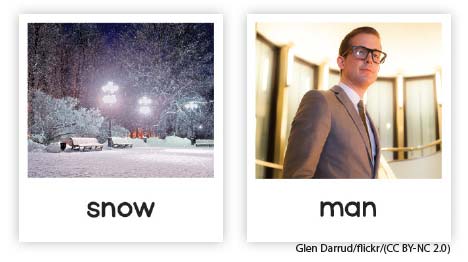 [Give an adult helper the word card “man” and you take word card “snow.”]
[Give an adult helper the word card “man” and you take word card “snow.”]
I would like to make a compound word. I have the word card that says “snow.” Who has the word card that says “man”?
[Invite the adult helper with the component word card “man” to stand next to you at the front of the room. Hold both component word cards together.]
The name of the picture on my card is “snow.” (Adult helper)’s card says “man.”
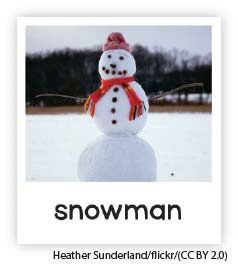 What compound word do we have when we put together the words “snow” and “man”? (snowman) Yes! We have snowman.
What compound word do we have when we put together the words “snow” and “man”? (snowman) Yes! We have snowman.
What can you tell us about the word “snowman”?
[Offer a brief description or definition of a snowman that draws attention to the compound word card picture. Be sure all children are able to see the compound word card.]
I will write snowman on our chart paper.
[Write the word “snowman” as you say the word.]
Let’s clap for each part of the compound word.
[Lead children in clapping two times, once for each part of the compound word, as you say the word together.]
I wonder what would happen if we switched our words around? Let’s try it!
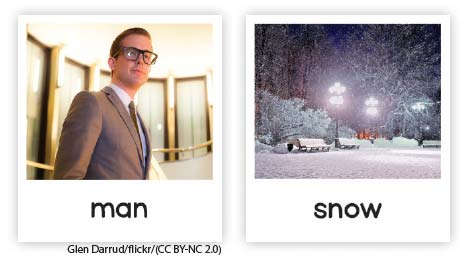 [Switch places with the adult helper and hold your cards together to make the word “mansnow.”]
[Switch places with the adult helper and hold your cards together to make the word “mansnow.”]
Now our new word is “mansnow.” That is a silly compound word! Have you ever heard the word “mansnow”? No! It’s not a real word. “Mansnow” does not mean the same thing as “snowman.” When we make compound words we need to put the words in the correct order.
Now it is your turn to make compound words!
[Do the activity demonstrated above for each pair of word cards. Example: “If you have the word “corn” or the word “bread” please come to the front of the room.” If children are unsure if they hold one of the designated cards, help if necessary (see Extra Support tip). For each pair of cards, invite children to make the new compound word and write it on the chart. Then invite children to switch places to make the new “silly” compound word. Continue until all children have had a turn.]
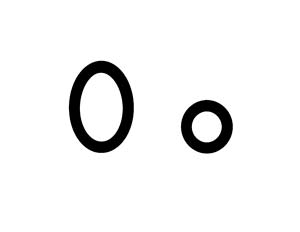 Let’s learn more about the letter O.
Let’s learn more about the letter O.
[Display letter O card.
If a child(ren) whose name begins with the letter O was identified on Day 2, invite the child(ren) to again pop up. Say the first name of the child(ren). Emphasize the sound of the letter O when you say the name.]
Maybe someone in our group has the letter o somewhere else in their name. The letter might be in the middle or at the end of their name. It will be a lowercase o and it will look like this.
[Point to the lowercase o on the letter card.]
Pop up if you have the letter o somewhere else in your name (not at beginning).
[If a child has the letter o somewhere else in his/her name, point to the name and to the letter o on the list of children’s first names so all children can see the name and the letter o.]
Who remembers our word that begins with the letter O? (observe)
The letter O says /o/, just like in the word “observe.” /o/, /o/, observe. Let’s say that together: /o/, /o/, observe.
I have two pictures of things that begin with the letter o. I wonder what they could be.

[Hold up one picture card and invite children to identify the animal/item in each picture. After children have an opportunity to guess or say the pictured animal/item, point to and say the word written at the bottom of the card. Example: “This word says octopus. The letter o is at the beginning of the word.” Repeat this procedure with a second picture card.]
Let’s think of some other words that start with the letter O and write them on our chart. Remember, the letter O says /o/, /o/.
[Help children by suggesting other words that start with o. Examples: otter, on, off, opposite, omelet.
Invite one or more volunteer children to find the letter o in words on the chart. Children may point to the letter at the top of the chart and then find it in one of the words below.
Demonstrate and describe how to mark the uppercase letter O on your chart paper.]
We use one line to make an uppercase O. The line curves around like this.
[Give each child his/her letter journal.]
Now we are going to write the letter O in our letter journal. Please write the uppercase (big) letter O in your journal. Write as much of the letter as you can.
Today we practiced putting two words together to make a new word. Who can tell us what the new word is called? (compound word) We made some silly compound words. How did we make silly words? (putting two words in the wrong order)
We also learned that the letter O says /o/, just like at the beginning of the word “observe.” We made the uppercase (big) letter O in our letter journal. Let’s say together the sound the letter O makes. (/o/)
Extra support
Enrichment
Provide *component and *compound word cards used in today’s activity. Encourage children to match component word cards to make new compound words. Then invite children to switch the two cards to make a new “silly” compound word.
*Printables provided
Provide *component word cards and invite children to randomly match two component word cards to make a new compound word. Invite school-age children to ask younger children if the word makes sense or is a “silly” compound word.
*Printables provided
Geometric and spatial knowledge
Children will identify and sort basic shapes of selected items.


New:
Review:

Be Prepared: Fill a basket with small items that represent a circle, square, triangle, or rectangle shape. Examples: blocks, books, shapes (pattern blocks), crayon boxes, napkins, play food items. Create a separate collection of four classroom items that do not represent one of the four shapes emphasized in the activity. Examples: doll, pencil, scissors, bottle of glue. On each tray, place a paper with one of the four basic shapes drawn on it.
[Display appropriate shape drawn on paper as you ask questions below:]
Today we are going to sort some items by shape.
What do you think it means to sort things?
When we sort, we put things into certain groups. Today we will look at some items in our classroom and decide which shape they are. Then we will put the item into a group with other items that have the same shape.
I have four trays. One tray is for circles. One tray is for squares. One tray is for rectangles. And one tray is for triangles. We will put each item on the correct tray.
After we decide the shape of each item, I would like you to tell us how you know.
[Invite each child to take a turn choosing an item from the basket, saying its shape, and putting it on the correct tray. Encourage children to describe the shape.]
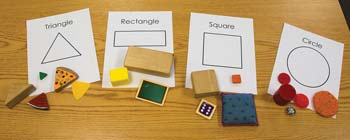
Let’s look at some other items from our classroom and decide if their shape is a circle, square, triangle, or rectangle.
[Hold up one of the four items that does not represent one of the four basic shapes shown in the trays.]
Today we sorted items in our classroom by shape. We looked at each item and decided which shape it was by looking at its outline, sides, and corners.
Extra support
Enrichment
Supply the sorting items used during today’s math activity. Encourage children to sort the items again.
Assign each child to a shape that the child is still learning (has limited or no familiarity with) and to a shape the child has mastered (able to name, describe). Ask the children to bring from home one item for each of the two assigned shapes that is in the form of the shape. Review the shape name and characteristics before and after the shapes are found at home.
Motor development
Children will practice turning different parts of their body.

None

New:
Review:

We are learning how to balance our bodies. Remember, when we balance something we keep it steady.
Today we will try to balance our bodies while we turn part of our bodies. When we turn something, we move it into a new position.
What parts of our body could we turn without hurting ourselves? (head, waist, legs)
[Demonstrate turning each of the following body parts. Point to the body part before you turn it. Encourage children to follow your lead.]
What else moves when we turn our waist? (shoulders, arms, maybe head)
Now I will say some ways we could turn our bodies. Try to move your body in the way I suggest. Please pay attention to keeping your balance. Remember, we can hold our arms to the side to help us keep our balance. Let’s stay in our own personal space so we do not bump into others.
[Offer as many of the following requests as time permits. Provide experience in turning each of the following: head, waist, a leg. The first part of the request is how to place our bodies and the second part is what to turn.]
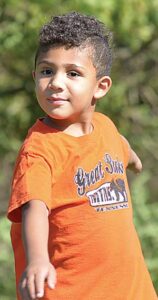
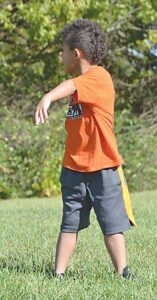
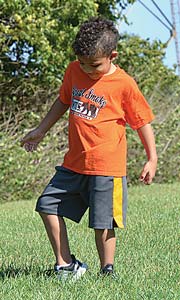
Today we practiced turning parts of our bodies. We turned our heads, waists, and legs. We did this while standing on our feet and our tiptoes, and sitting on our bottoms! We are learning how our body works when we move parts of our body.
Extra support
Enrichment
Invite children to take turns being the person who requests different ways to place our body and turn part of our body.
School-age children who participate in organized or informal sports may enjoy demonstrating how they keep their balance while turning a part of their body during a sport.
Appreciating Our Families
Social Studies
Skill and Goal
Appreciation of individual and family diversity
Children will understand the concept of cultural differences across families.
Materials
Needed
Key
Concepts
New:
Optional
Reading
Today is a very special day! We have guests who are going to help us learn more about how families are unique. Remember, no two families are exactly the same.
Families live all over the world in many different countries. Families from different countries may do things differently. Or, families from different countries may do things the same way.
Today our guests will help us learn about families in different cultures. A culture is a group of people who have a similar way of thinking and doing things. There are many cultures within countries and all over the world.
[Introduce each guest. Follow the plan agreed upon in advance with each guest. Discussion questions might include the following:
We are going to start a Family Culture Shelf in our classroom. Our Family Culture Shelf will be an area where you can share something from your home that is special to your family’s culture. For example, in many cultures, people use chopsticks to eat. This is different from the spoon, fork, and knife used in many other cultures. Chopsticks would be an interesting thing to share.
We will use our Family Culture Shelf throughout the year. We can place something in this area that is special to our family’s culture. Then during a special time each day, we will share our items.
The items on our shelf are very special and will belong to our families. We should not touch the items unless an adult is helping us.
Today I am going to invite our guests to describe an item they brought to our classroom.
[If guests do not wish to contribute their item to the Family Culture Shelf, please take a picture of it and place the picture on the shelf.]
Today we learned about families from different cultures (or a different culture). Please join me in clapping as a way of thanking our guests for sharing with us today!
Scaffolding Tips
Extra support
Enrichment
Center Activity
Provide music from different cultures. Invite children to dance along to the music. Provide cultural clothing to wear while dancing, if possible.
Family Child Care
Prepare a lunch item or snack from a different culture. Look for the following or other cultural cookbooks for children at your local library: The 2nd International Cookbook for Kids by Matthew Locricchio. Also, invite children to bring from home a favorite recipe for a snack or lunch item. Invite all children in your setting to help prepare the snack or lunch item.